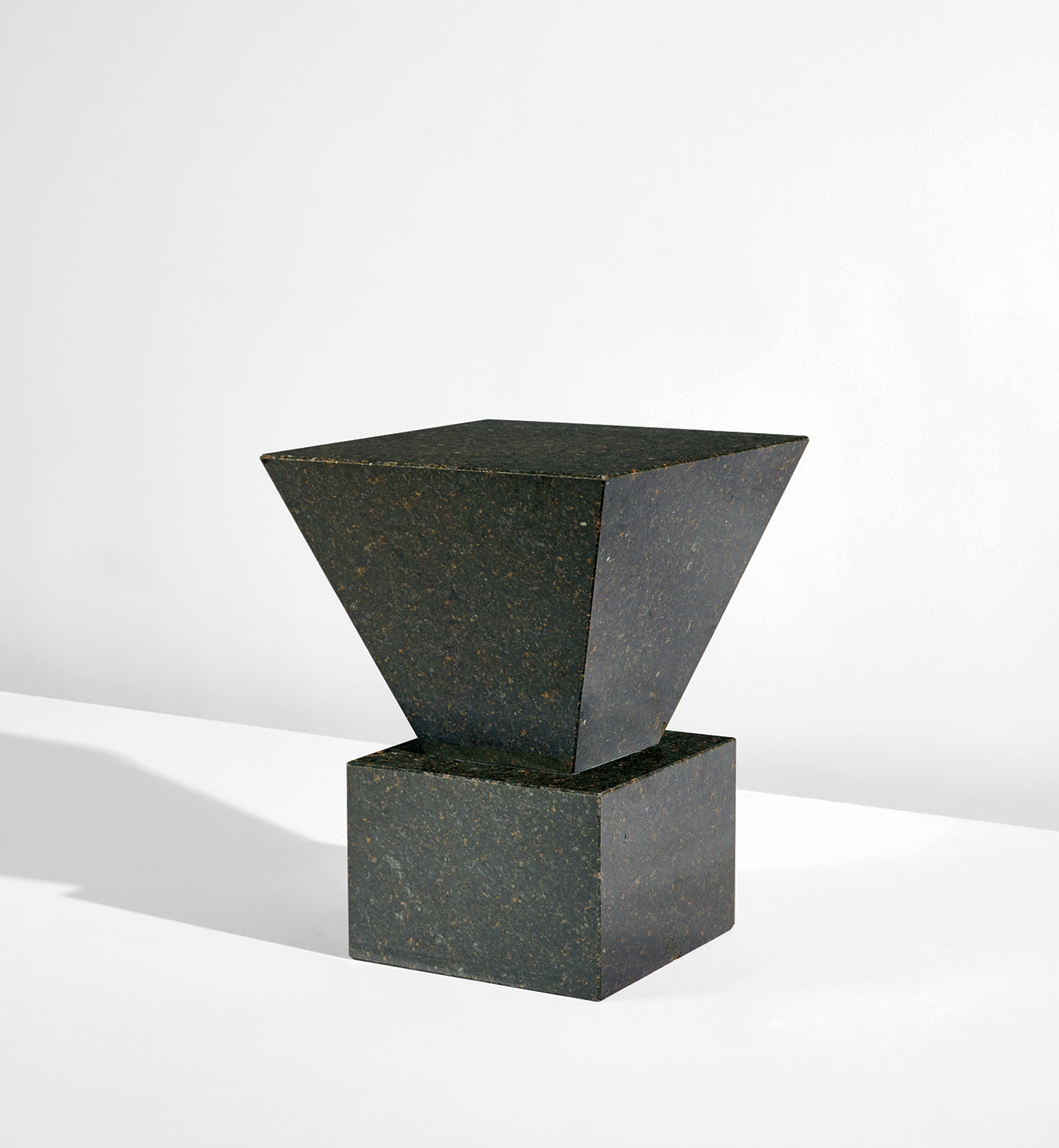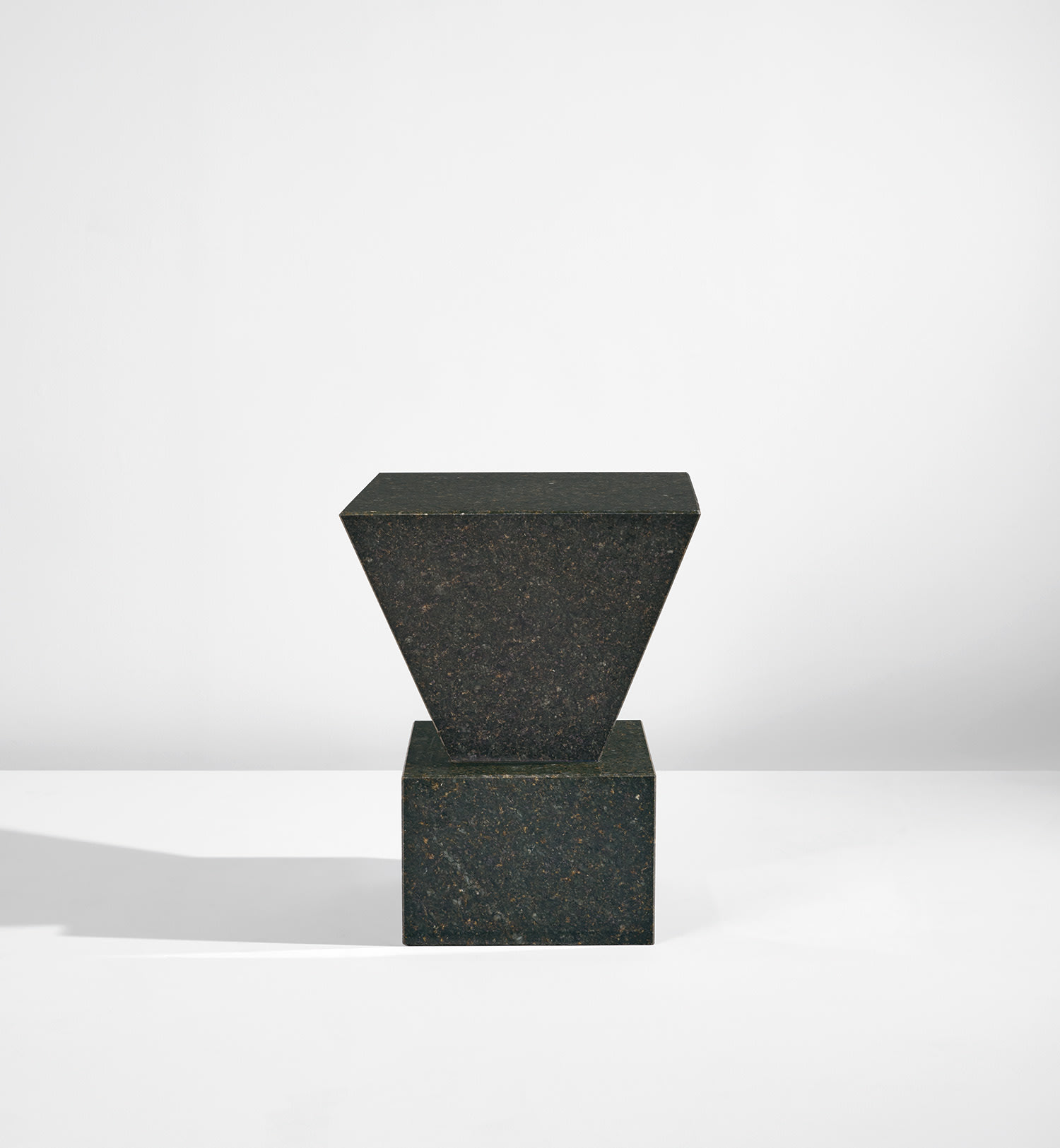





Property from the Collection of Jonathan Zanger, New York
62
Scott Burton
"Café Table"
designed 1984, produced 1985
Verde Ubatuba granite.
28 x 22 x 22 in. (71.1 x 55.9 x 55.9 cm)
Granite cut and polished in Ardenno, Italy under the supervision of Walker Zanger, New York. Artist's proof 1 from the edition of 10 plus 2 artist's proofs.
Full-Cataloguing
Double Vision: Scott Burton
by Elizabeth Essner
In 1989, the Museum of Modern Art organized its first Artist’s Choice exhibition, a still‐ongoing series in which an artist is invited to select works in the museum’s collection. Sculptor Scott Burton was the inaugural choice, and Burton on Brancusi was the resulting exhibition, an incisive analysis of the celebrated Romanian artist Constantin Brancusi (1876‐1957), investigated from the pedestal up. Burton asserted the integral and, at times, autonomous significance of the artist’s pedestal and furniture forms made a half century before—even controversially exhibiting one of Brancusi’s pedestals on its own. “His best pieces of furniture are not only functional objects but also representations of functional objects,” Burton wrote of Brancusi.¹ In this double presence, both “object and subject,” Burton could have also easily described his own work.²
The present lot, Burton’s Café Table, aptly demonstrates this duality: it is at once a sculpture and a table, functioning as both. Grounded in careful geometry, an inverted trapezoid prism (not unlike a slice of Brancusi’s Endless Column) is stacked atop a cube. Like many of his table forms of the period it is unincumbered by legs, instead its pedestal base eases the user’s physical interaction. Perhaps this is also a nod to another key influence, Gerrit Rietveld (1888‐1964), whose Zig Zag chair of 1934 is likewise absolved from four legs, solved instead with cantilevered planes of wood. The deep green gravitas of the Café Table’s verde ubatuba granite secures its visual and literal weight, the rigor of its sharp polished edges cut against space itself. And yet in profile, a subtle figural form appears: broad shoulders, slim waist. All the while, the top—a perfect square—embraces the daily social acts the typology implies.
Burton, who died in 1989 of complications related to AIDS at just fifty years old, believed that art should ''place itself not in front of, but around, behind, underneath (literally) the audience.''³ Furniture delivered Burton’s message of human contact. In his mature work of the 1980s—both singular pieces and civic plazas—Burton used the language of his Minimalist predecessors, but challenged their idea of purity. Instead, within his spare forms, the sculptor offered a kind of blank canvas for individual emotional affect.
Burton began his career as a sharp‐eyed art critic, rising to editorial roles at Art News and Art in America in the decade that followed his 1963 master’s degree in English from New York University. He turned towards his own artistic practice by the early 1970s, notably, performance works like Behavior Tableaux. In these slow‐motion living pictures, or tableaux vivants, Burton set the stage for the body language of human behavior. His first furniture work came concurrently, Bronze Chair, a found revival‐style Queen Anne chair cast in bronze. The sculptor sited it on a Soho street outside his solo exhibition at Artists Space in 1975—the essence of his sculptural questions asked most succinctly by design.
As the sculptor continued to pursue furniture forms, materials became primary: plywood, acrylic, rubber, glass, mother of pearl all came under Burton’s purview. For a brief moment in the early 1980s, Burton experimented with cast concrete, which, as [Lot XX], a pair of tables, demonstrates, he handled with Brutalist precision.
There is a formal lineage from these to the Café Table, designed in 1984. By this time Burton had honed his vocabulary, often favoring the graceful endurance of stone, especially granite. Café Table was made in 1985, shown in his solo exhibition at the Tate Gallery in London, with examples in the collections of the Philadelphia Museum of Art and the Des Moines Art Center. Its fabrication was overseen by the trusted firm of Walker Zanger who often worked with the artist on his growing roster of projects, including the Urban Plazas that now anchor 51st Street between 6th and 7th Avenue in Manhattan. Engaged in studio works and environments—Pearlstone Park in Baltimore, World Financial Center in New York—until the end, Burton’s sculpture hides in plain sight, around, behind, and underneath his audience.
¹ Scott Burton, “My Brancusi,” Artist’s Choice: Burton on Brancusi, exh. cat., Museum of Modern Art, April 7-June 28, 1989, np.
² Ibid.
³ Quoted in “Situation Esthetics: Impermanent Art and the Seventies Audience,” Art Forum, January 1980, p. 23.
by Elizabeth Essner
In 1989, the Museum of Modern Art organized its first Artist’s Choice exhibition, a still‐ongoing series in which an artist is invited to select works in the museum’s collection. Sculptor Scott Burton was the inaugural choice, and Burton on Brancusi was the resulting exhibition, an incisive analysis of the celebrated Romanian artist Constantin Brancusi (1876‐1957), investigated from the pedestal up. Burton asserted the integral and, at times, autonomous significance of the artist’s pedestal and furniture forms made a half century before—even controversially exhibiting one of Brancusi’s pedestals on its own. “His best pieces of furniture are not only functional objects but also representations of functional objects,” Burton wrote of Brancusi.¹ In this double presence, both “object and subject,” Burton could have also easily described his own work.²
The present lot, Burton’s Café Table, aptly demonstrates this duality: it is at once a sculpture and a table, functioning as both. Grounded in careful geometry, an inverted trapezoid prism (not unlike a slice of Brancusi’s Endless Column) is stacked atop a cube. Like many of his table forms of the period it is unincumbered by legs, instead its pedestal base eases the user’s physical interaction. Perhaps this is also a nod to another key influence, Gerrit Rietveld (1888‐1964), whose Zig Zag chair of 1934 is likewise absolved from four legs, solved instead with cantilevered planes of wood. The deep green gravitas of the Café Table’s verde ubatuba granite secures its visual and literal weight, the rigor of its sharp polished edges cut against space itself. And yet in profile, a subtle figural form appears: broad shoulders, slim waist. All the while, the top—a perfect square—embraces the daily social acts the typology implies.
Burton, who died in 1989 of complications related to AIDS at just fifty years old, believed that art should ''place itself not in front of, but around, behind, underneath (literally) the audience.''³ Furniture delivered Burton’s message of human contact. In his mature work of the 1980s—both singular pieces and civic plazas—Burton used the language of his Minimalist predecessors, but challenged their idea of purity. Instead, within his spare forms, the sculptor offered a kind of blank canvas for individual emotional affect.
Burton began his career as a sharp‐eyed art critic, rising to editorial roles at Art News and Art in America in the decade that followed his 1963 master’s degree in English from New York University. He turned towards his own artistic practice by the early 1970s, notably, performance works like Behavior Tableaux. In these slow‐motion living pictures, or tableaux vivants, Burton set the stage for the body language of human behavior. His first furniture work came concurrently, Bronze Chair, a found revival‐style Queen Anne chair cast in bronze. The sculptor sited it on a Soho street outside his solo exhibition at Artists Space in 1975—the essence of his sculptural questions asked most succinctly by design.
As the sculptor continued to pursue furniture forms, materials became primary: plywood, acrylic, rubber, glass, mother of pearl all came under Burton’s purview. For a brief moment in the early 1980s, Burton experimented with cast concrete, which, as [Lot XX], a pair of tables, demonstrates, he handled with Brutalist precision.
There is a formal lineage from these to the Café Table, designed in 1984. By this time Burton had honed his vocabulary, often favoring the graceful endurance of stone, especially granite. Café Table was made in 1985, shown in his solo exhibition at the Tate Gallery in London, with examples in the collections of the Philadelphia Museum of Art and the Des Moines Art Center. Its fabrication was overseen by the trusted firm of Walker Zanger who often worked with the artist on his growing roster of projects, including the Urban Plazas that now anchor 51st Street between 6th and 7th Avenue in Manhattan. Engaged in studio works and environments—Pearlstone Park in Baltimore, World Financial Center in New York—until the end, Burton’s sculpture hides in plain sight, around, behind, and underneath his audience.
¹ Scott Burton, “My Brancusi,” Artist’s Choice: Burton on Brancusi, exh. cat., Museum of Modern Art, April 7-June 28, 1989, np.
² Ibid.
³ Quoted in “Situation Esthetics: Impermanent Art and the Seventies Audience,” Art Forum, January 1980, p. 23.